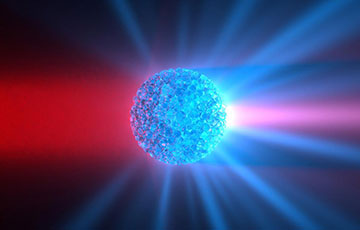
Researchers at ETH Zurich have shown how micrometer-sized spheres of barium titanate nanocrystals made using a simple recipe can convert red light into blue. [ETH Zurich / Jolanda Mueller]
Nonlinear crystals are exploited in everything from spectroscopy to quantum cryptography, being able to generate optical frequencies not attainable directly with a laser as well as provide entangled photons. But those crystals have their limitations, in particular the need to fine tune the light’s phase.
Now, researchers in Switzerland have shown how to relax those conditions while at the same time maximizing the output of frequency-doubled light, by assembling tiny metal-oxide crystals into micrometer-sized spheres (Nat. Photon., doi: 10.1038/s41566-020-00701-x).
Second-harmonic generation
Crystals without inversion symmetry can combine two lower-energy photons into a single photon with twice the frequency, thanks to their second-order nonlinearity. But such second-harmonic generation requires carefully setting the incoming light’s polarization so as to avoid destructive interference that would cancel the signal.
This stringent requirement can be eased by using non-uniform crystals made up of many individual domains. With the crystalline axis of each domain randomly aligned, the second harmonics are generated with random phases and amplitudes. Averaging over many domains removes the destructive interference, regardless of the light’s direction and polarization.
A spherical solution
In the latest research, OSA member Rachel Grange, Romolo Savo and colleagues at the Institute for Quantum Electronics at ETH Zurich, Switzerland, have combined this eased phase-matching with resonant enhancement of second harmonics. They do so by assembling large numbers of individual barium titanate nanocrystals into spheres measuring a few micrometers across. The spheres increase nonlinear interactions between light and matter by confining incoming light, leading to more frequency-doubled light at the output.
The researchers made their microspheres using a recipe proposed by Lucio Isa, a colleague in ETH Zurich’s department of materials. That recipe involves first dissolving a powder of roughly 50-nm-diameter nanocrystals in water and then mixing the solution with oil. By then shaking the mixture they create an emulsion of water droplets within the oil. After the water evaporates, it leaves behind almost perfectly spherical assemblies of randomly aligned nanocrystals—the particles’ surface roughness dictated simply by the finite size of the crystals.
To test their scheme, Grange and colleagues placed a series of such spheres with diameters between 1 μm and 12 μm on a glass slide and illuminated them with brief pulses of infrared light at 930 nm. They found that the power of the second harmonic (at 465 nm) scaled linearly with the volume of the spheres over four orders of magnitude—showing the alignment of the constituent nanocrystals to be perfectly random (something confirmed by speckle-pattern statistics). They also modeled the behavior of the spheres and concluded that their resonance effect boosted the power of the output blue light by an order of magnitude.
What’s more, the researchers found that they could generate second-harmonic signals across a 100-nm-wide range of pump wavelengths, with the position of the intensity peaks in the spectrum of blue light dependent on the diameter of the sphere used to generate that light.
Optimizing microspheres
According to Grange and co-workers, the ready availability of nanocrystal powder makes the technology significantly cheaper than traditional nonlinear devices that require the growth of perfect crystals. They say that the microspheres could be used to cover large surface areas, possibly enabling new kinds of display that double the frequency of infrared data to yield images in the visible—and which could potentially be integrated into security cameras and medical imagers.
First, however, they want to optimize the spheres. For one thing, they need to cut down the amount of light leaking from the sphere to the glass slide, which they estimate at between 20% and 50% of the total (depending on input wavelength and the sphere’s radius). One option, they say, would be to put a silica spacer between spheres and slide. Savo says that the kind of spacer they have in mind to best isolate the spheres is a post or rod. But he acknowledges that developing this will not be easy. “Positioning a sphere on the top of a post is always challenging, especially on a scale of few micrometers,” he says.
